Marketing Consumer Behavior: Satisfaction, Loyalty, and Repurchasing
VerifiedAdded on 2023/06/14
|9
|2210
|296
Report
AI Summary
This report analyzes a research article focusing on the relationship between customer satisfaction and customer loyalty in marketing. It challenges the traditional view that high customer satisfaction leads to high repurchasing intention, introducing the concepts of 'Escape Assistants' (customers l...
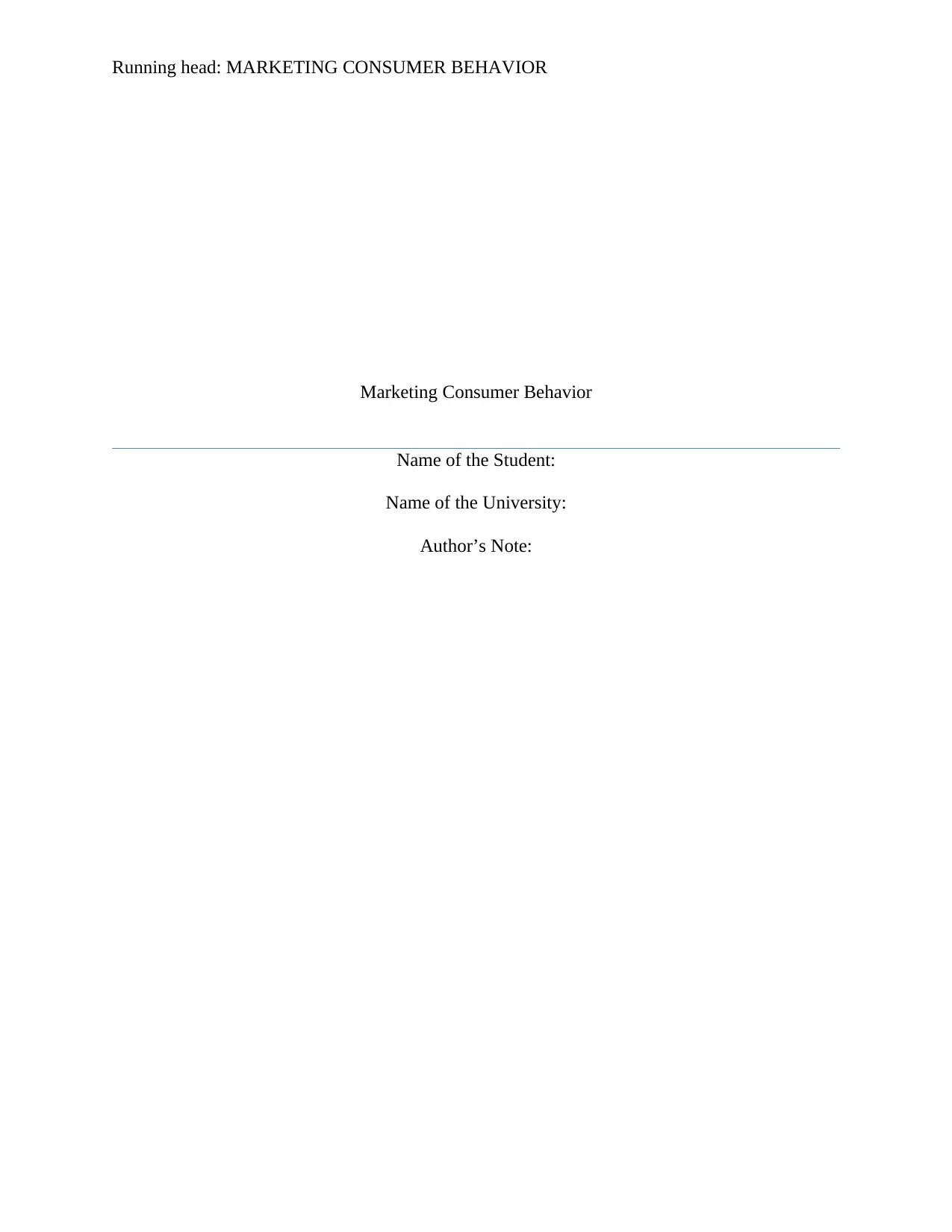
Running head: MARKETING CONSUMER BEHAVIOR
Marketing Consumer Behavior
Name of the Student:
Name of the University:
Author’s Note:
Marketing Consumer Behavior
Name of the Student:
Name of the University:
Author’s Note:
Paraphrase This Document
Need a fresh take? Get an instant paraphrase of this document with our AI Paraphraser
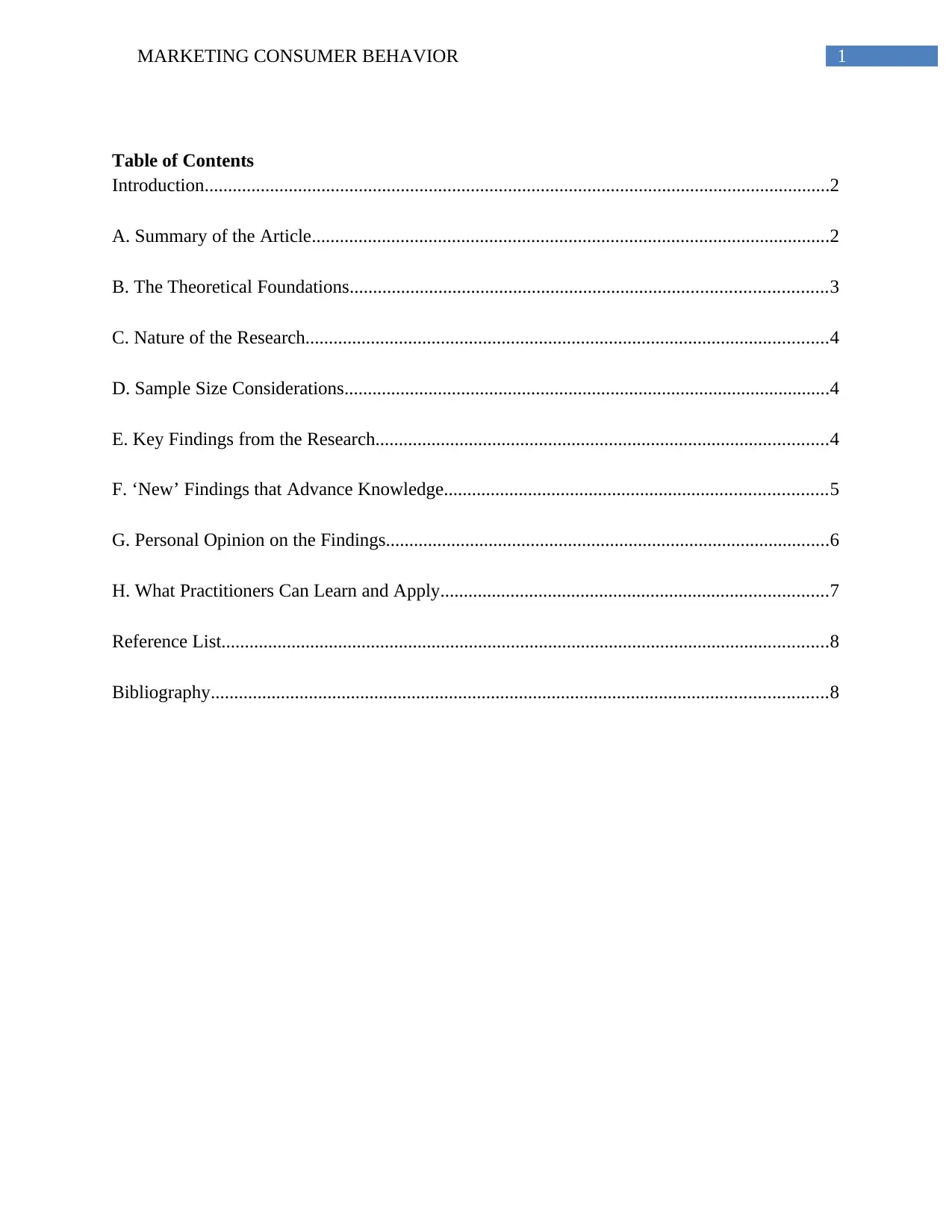
1MARKETING CONSUMER BEHAVIOR
Table of Contents
Introduction......................................................................................................................................2
A. Summary of the Article...............................................................................................................2
B. The Theoretical Foundations......................................................................................................3
C. Nature of the Research................................................................................................................4
D. Sample Size Considerations........................................................................................................4
E. Key Findings from the Research.................................................................................................4
F. ‘New’ Findings that Advance Knowledge..................................................................................5
G. Personal Opinion on the Findings...............................................................................................6
H. What Practitioners Can Learn and Apply...................................................................................7
Reference List..................................................................................................................................8
Bibliography....................................................................................................................................8
Table of Contents
Introduction......................................................................................................................................2
A. Summary of the Article...............................................................................................................2
B. The Theoretical Foundations......................................................................................................3
C. Nature of the Research................................................................................................................4
D. Sample Size Considerations........................................................................................................4
E. Key Findings from the Research.................................................................................................4
F. ‘New’ Findings that Advance Knowledge..................................................................................5
G. Personal Opinion on the Findings...............................................................................................6
H. What Practitioners Can Learn and Apply...................................................................................7
Reference List..................................................................................................................................8
Bibliography....................................................................................................................................8
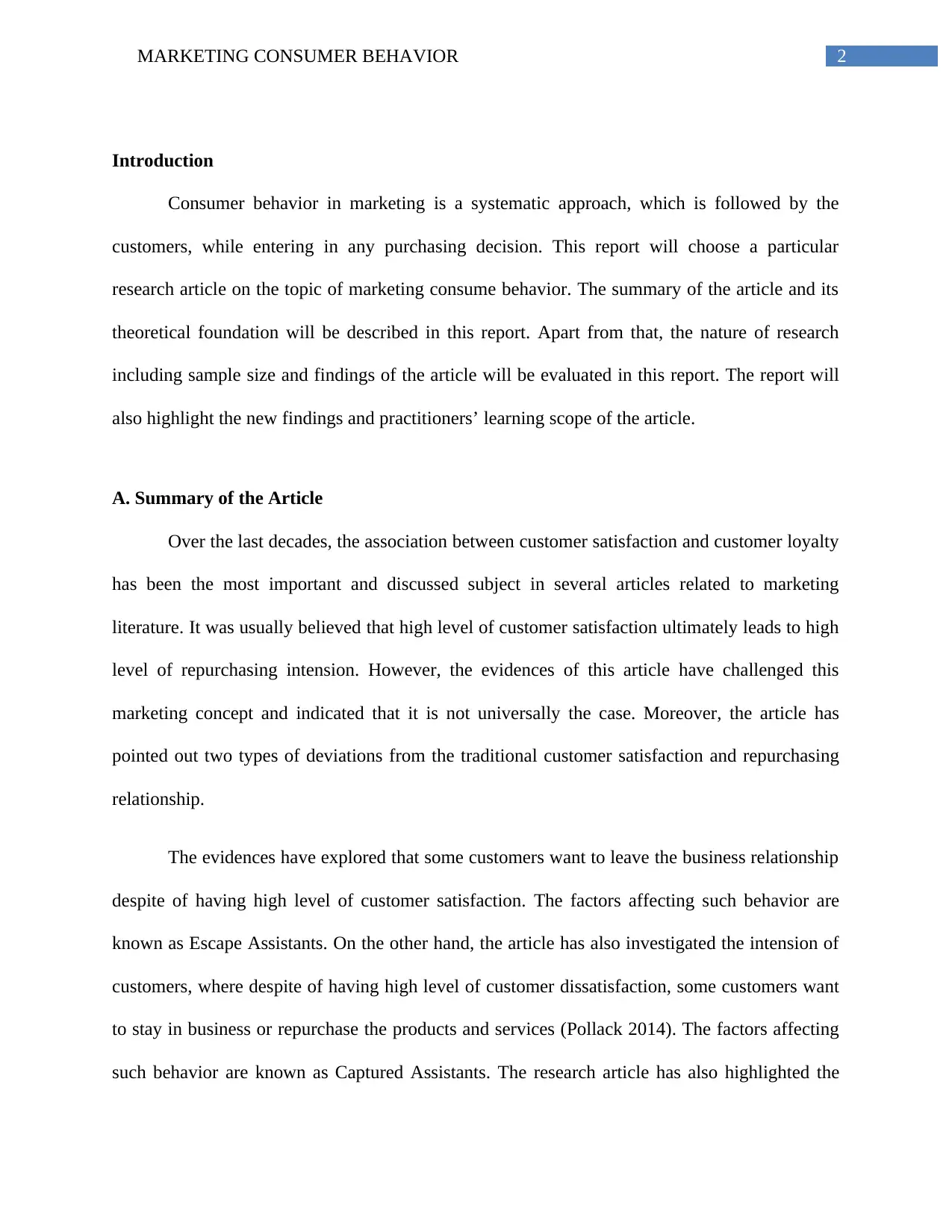
2MARKETING CONSUMER BEHAVIOR
Introduction
Consumer behavior in marketing is a systematic approach, which is followed by the
customers, while entering in any purchasing decision. This report will choose a particular
research article on the topic of marketing consume behavior. The summary of the article and its
theoretical foundation will be described in this report. Apart from that, the nature of research
including sample size and findings of the article will be evaluated in this report. The report will
also highlight the new findings and practitioners’ learning scope of the article.
A. Summary of the Article
Over the last decades, the association between customer satisfaction and customer loyalty
has been the most important and discussed subject in several articles related to marketing
literature. It was usually believed that high level of customer satisfaction ultimately leads to high
level of repurchasing intension. However, the evidences of this article have challenged this
marketing concept and indicated that it is not universally the case. Moreover, the article has
pointed out two types of deviations from the traditional customer satisfaction and repurchasing
relationship.
The evidences have explored that some customers want to leave the business relationship
despite of having high level of customer satisfaction. The factors affecting such behavior are
known as Escape Assistants. On the other hand, the article has also investigated the intension of
customers, where despite of having high level of customer dissatisfaction, some customers want
to stay in business or repurchase the products and services (Pollack 2014). The factors affecting
such behavior are known as Captured Assistants. The research article has also highlighted the
Introduction
Consumer behavior in marketing is a systematic approach, which is followed by the
customers, while entering in any purchasing decision. This report will choose a particular
research article on the topic of marketing consume behavior. The summary of the article and its
theoretical foundation will be described in this report. Apart from that, the nature of research
including sample size and findings of the article will be evaluated in this report. The report will
also highlight the new findings and practitioners’ learning scope of the article.
A. Summary of the Article
Over the last decades, the association between customer satisfaction and customer loyalty
has been the most important and discussed subject in several articles related to marketing
literature. It was usually believed that high level of customer satisfaction ultimately leads to high
level of repurchasing intension. However, the evidences of this article have challenged this
marketing concept and indicated that it is not universally the case. Moreover, the article has
pointed out two types of deviations from the traditional customer satisfaction and repurchasing
relationship.
The evidences have explored that some customers want to leave the business relationship
despite of having high level of customer satisfaction. The factors affecting such behavior are
known as Escape Assistants. On the other hand, the article has also investigated the intension of
customers, where despite of having high level of customer dissatisfaction, some customers want
to stay in business or repurchase the products and services (Pollack 2014). The factors affecting
such behavior are known as Captured Assistants. The research article has also highlighted the
You're viewing a preview
Unlock full access by subscribing today!
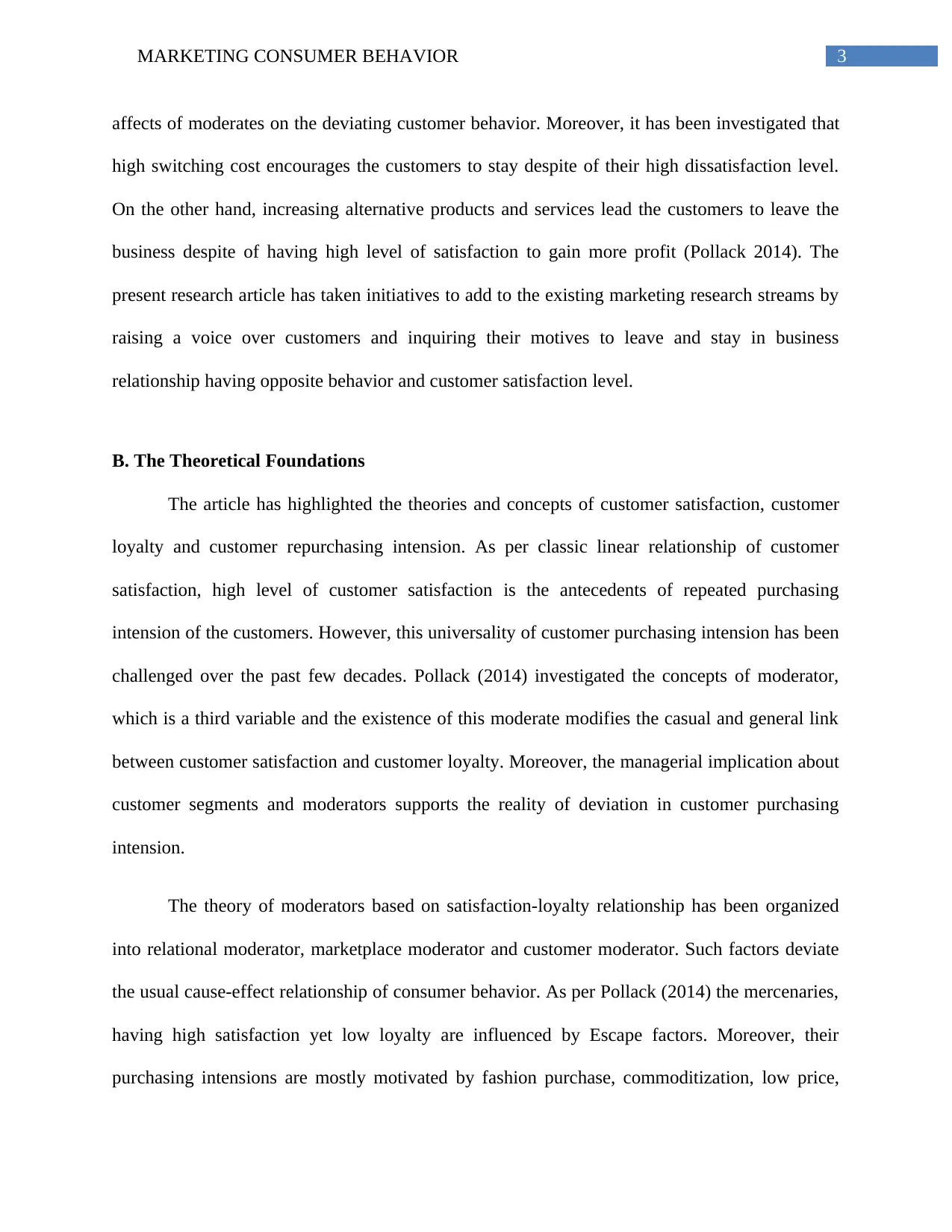
3MARKETING CONSUMER BEHAVIOR
affects of moderates on the deviating customer behavior. Moreover, it has been investigated that
high switching cost encourages the customers to stay despite of their high dissatisfaction level.
On the other hand, increasing alternative products and services lead the customers to leave the
business despite of having high level of satisfaction to gain more profit (Pollack 2014). The
present research article has taken initiatives to add to the existing marketing research streams by
raising a voice over customers and inquiring their motives to leave and stay in business
relationship having opposite behavior and customer satisfaction level.
B. The Theoretical Foundations
The article has highlighted the theories and concepts of customer satisfaction, customer
loyalty and customer repurchasing intension. As per classic linear relationship of customer
satisfaction, high level of customer satisfaction is the antecedents of repeated purchasing
intension of the customers. However, this universality of customer purchasing intension has been
challenged over the past few decades. Pollack (2014) investigated the concepts of moderator,
which is a third variable and the existence of this moderate modifies the casual and general link
between customer satisfaction and customer loyalty. Moreover, the managerial implication about
customer segments and moderators supports the reality of deviation in customer purchasing
intension.
The theory of moderators based on satisfaction-loyalty relationship has been organized
into relational moderator, marketplace moderator and customer moderator. Such factors deviate
the usual cause-effect relationship of consumer behavior. As per Pollack (2014) the mercenaries,
having high satisfaction yet low loyalty are influenced by Escape factors. Moreover, their
purchasing intensions are mostly motivated by fashion purchase, commoditization, low price,
affects of moderates on the deviating customer behavior. Moreover, it has been investigated that
high switching cost encourages the customers to stay despite of their high dissatisfaction level.
On the other hand, increasing alternative products and services lead the customers to leave the
business despite of having high level of satisfaction to gain more profit (Pollack 2014). The
present research article has taken initiatives to add to the existing marketing research streams by
raising a voice over customers and inquiring their motives to leave and stay in business
relationship having opposite behavior and customer satisfaction level.
B. The Theoretical Foundations
The article has highlighted the theories and concepts of customer satisfaction, customer
loyalty and customer repurchasing intension. As per classic linear relationship of customer
satisfaction, high level of customer satisfaction is the antecedents of repeated purchasing
intension of the customers. However, this universality of customer purchasing intension has been
challenged over the past few decades. Pollack (2014) investigated the concepts of moderator,
which is a third variable and the existence of this moderate modifies the casual and general link
between customer satisfaction and customer loyalty. Moreover, the managerial implication about
customer segments and moderators supports the reality of deviation in customer purchasing
intension.
The theory of moderators based on satisfaction-loyalty relationship has been organized
into relational moderator, marketplace moderator and customer moderator. Such factors deviate
the usual cause-effect relationship of consumer behavior. As per Pollack (2014) the mercenaries,
having high satisfaction yet low loyalty are influenced by Escape factors. Moreover, their
purchasing intensions are mostly motivated by fashion purchase, commoditization, low price,
Paraphrase This Document
Need a fresh take? Get an instant paraphrase of this document with our AI Paraphraser
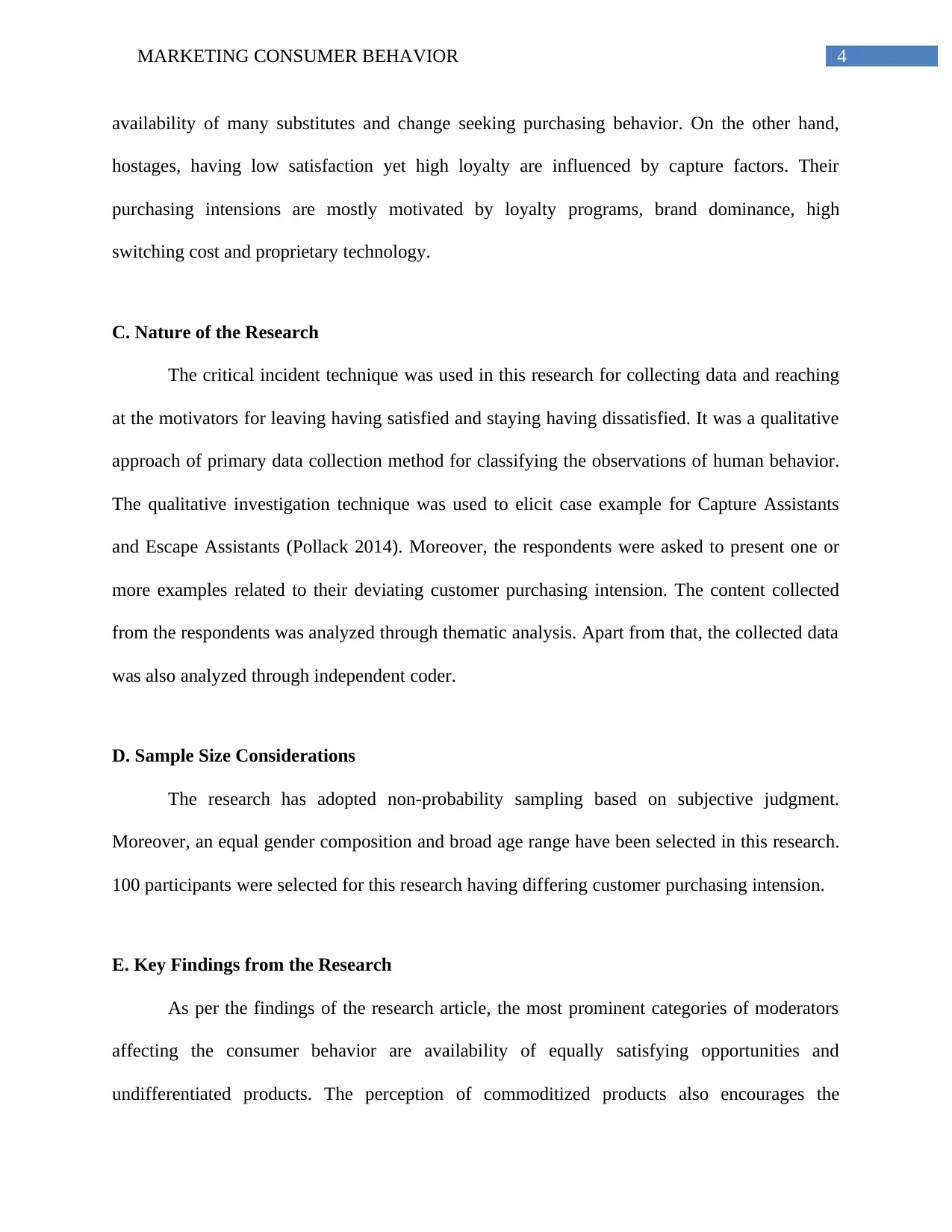
4MARKETING CONSUMER BEHAVIOR
availability of many substitutes and change seeking purchasing behavior. On the other hand,
hostages, having low satisfaction yet high loyalty are influenced by capture factors. Their
purchasing intensions are mostly motivated by loyalty programs, brand dominance, high
switching cost and proprietary technology.
C. Nature of the Research
The critical incident technique was used in this research for collecting data and reaching
at the motivators for leaving having satisfied and staying having dissatisfied. It was a qualitative
approach of primary data collection method for classifying the observations of human behavior.
The qualitative investigation technique was used to elicit case example for Capture Assistants
and Escape Assistants (Pollack 2014). Moreover, the respondents were asked to present one or
more examples related to their deviating customer purchasing intension. The content collected
from the respondents was analyzed through thematic analysis. Apart from that, the collected data
was also analyzed through independent coder.
D. Sample Size Considerations
The research has adopted non-probability sampling based on subjective judgment.
Moreover, an equal gender composition and broad age range have been selected in this research.
100 participants were selected for this research having differing customer purchasing intension.
E. Key Findings from the Research
As per the findings of the research article, the most prominent categories of moderators
affecting the consumer behavior are availability of equally satisfying opportunities and
undifferentiated products. The perception of commoditized products also encourages the
availability of many substitutes and change seeking purchasing behavior. On the other hand,
hostages, having low satisfaction yet high loyalty are influenced by capture factors. Their
purchasing intensions are mostly motivated by loyalty programs, brand dominance, high
switching cost and proprietary technology.
C. Nature of the Research
The critical incident technique was used in this research for collecting data and reaching
at the motivators for leaving having satisfied and staying having dissatisfied. It was a qualitative
approach of primary data collection method for classifying the observations of human behavior.
The qualitative investigation technique was used to elicit case example for Capture Assistants
and Escape Assistants (Pollack 2014). Moreover, the respondents were asked to present one or
more examples related to their deviating customer purchasing intension. The content collected
from the respondents was analyzed through thematic analysis. Apart from that, the collected data
was also analyzed through independent coder.
D. Sample Size Considerations
The research has adopted non-probability sampling based on subjective judgment.
Moreover, an equal gender composition and broad age range have been selected in this research.
100 participants were selected for this research having differing customer purchasing intension.
E. Key Findings from the Research
As per the findings of the research article, the most prominent categories of moderators
affecting the consumer behavior are availability of equally satisfying opportunities and
undifferentiated products. The perception of commoditized products also encourages the
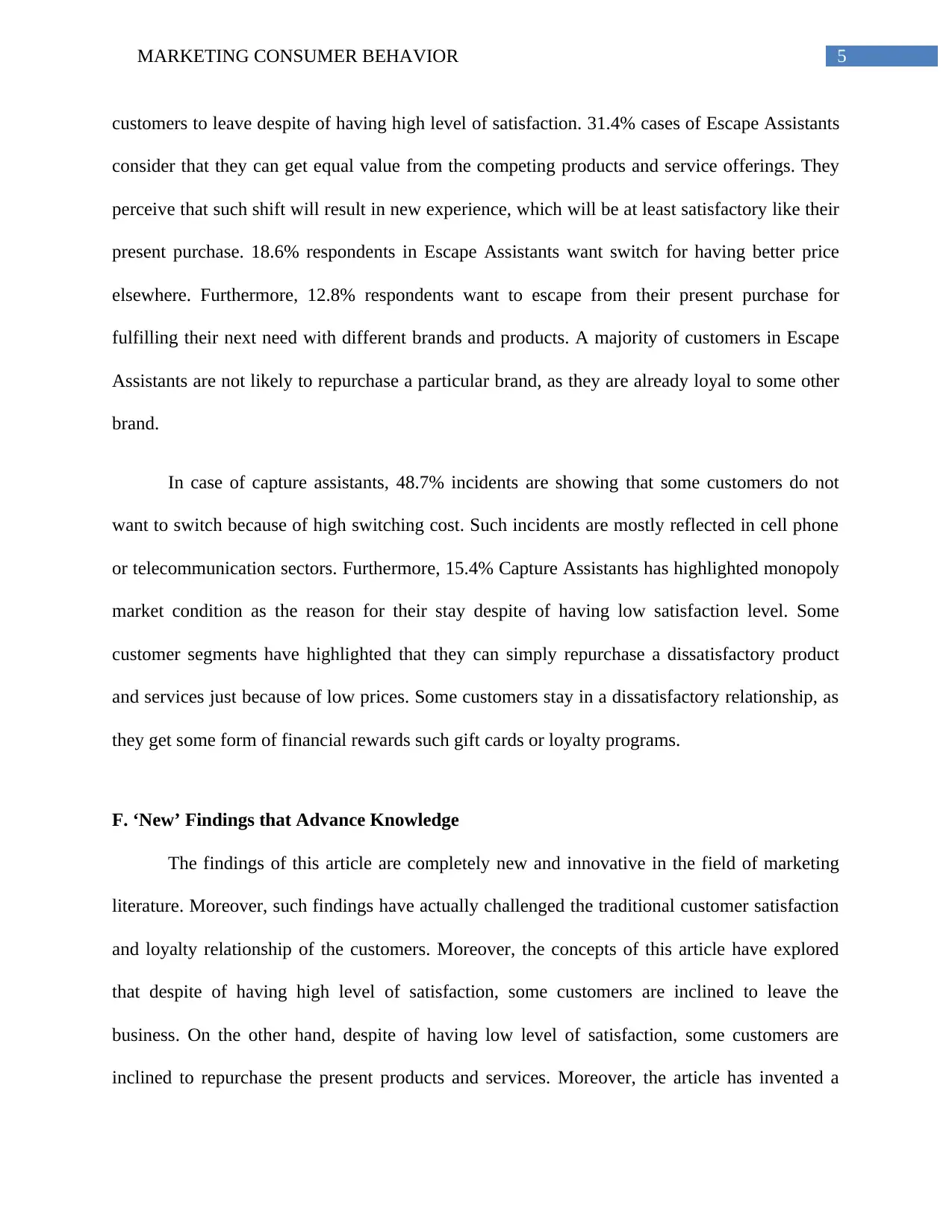
5MARKETING CONSUMER BEHAVIOR
customers to leave despite of having high level of satisfaction. 31.4% cases of Escape Assistants
consider that they can get equal value from the competing products and service offerings. They
perceive that such shift will result in new experience, which will be at least satisfactory like their
present purchase. 18.6% respondents in Escape Assistants want switch for having better price
elsewhere. Furthermore, 12.8% respondents want to escape from their present purchase for
fulfilling their next need with different brands and products. A majority of customers in Escape
Assistants are not likely to repurchase a particular brand, as they are already loyal to some other
brand.
In case of capture assistants, 48.7% incidents are showing that some customers do not
want to switch because of high switching cost. Such incidents are mostly reflected in cell phone
or telecommunication sectors. Furthermore, 15.4% Capture Assistants has highlighted monopoly
market condition as the reason for their stay despite of having low satisfaction level. Some
customer segments have highlighted that they can simply repurchase a dissatisfactory product
and services just because of low prices. Some customers stay in a dissatisfactory relationship, as
they get some form of financial rewards such gift cards or loyalty programs.
F. ‘New’ Findings that Advance Knowledge
The findings of this article are completely new and innovative in the field of marketing
literature. Moreover, such findings have actually challenged the traditional customer satisfaction
and loyalty relationship of the customers. Moreover, the concepts of this article have explored
that despite of having high level of satisfaction, some customers are inclined to leave the
business. On the other hand, despite of having low level of satisfaction, some customers are
inclined to repurchase the present products and services. Moreover, the article has invented a
customers to leave despite of having high level of satisfaction. 31.4% cases of Escape Assistants
consider that they can get equal value from the competing products and service offerings. They
perceive that such shift will result in new experience, which will be at least satisfactory like their
present purchase. 18.6% respondents in Escape Assistants want switch for having better price
elsewhere. Furthermore, 12.8% respondents want to escape from their present purchase for
fulfilling their next need with different brands and products. A majority of customers in Escape
Assistants are not likely to repurchase a particular brand, as they are already loyal to some other
brand.
In case of capture assistants, 48.7% incidents are showing that some customers do not
want to switch because of high switching cost. Such incidents are mostly reflected in cell phone
or telecommunication sectors. Furthermore, 15.4% Capture Assistants has highlighted monopoly
market condition as the reason for their stay despite of having low satisfaction level. Some
customer segments have highlighted that they can simply repurchase a dissatisfactory product
and services just because of low prices. Some customers stay in a dissatisfactory relationship, as
they get some form of financial rewards such gift cards or loyalty programs.
F. ‘New’ Findings that Advance Knowledge
The findings of this article are completely new and innovative in the field of marketing
literature. Moreover, such findings have actually challenged the traditional customer satisfaction
and loyalty relationship of the customers. Moreover, the concepts of this article have explored
that despite of having high level of satisfaction, some customers are inclined to leave the
business. On the other hand, despite of having low level of satisfaction, some customers are
inclined to repurchase the present products and services. Moreover, the article has invented a
You're viewing a preview
Unlock full access by subscribing today!
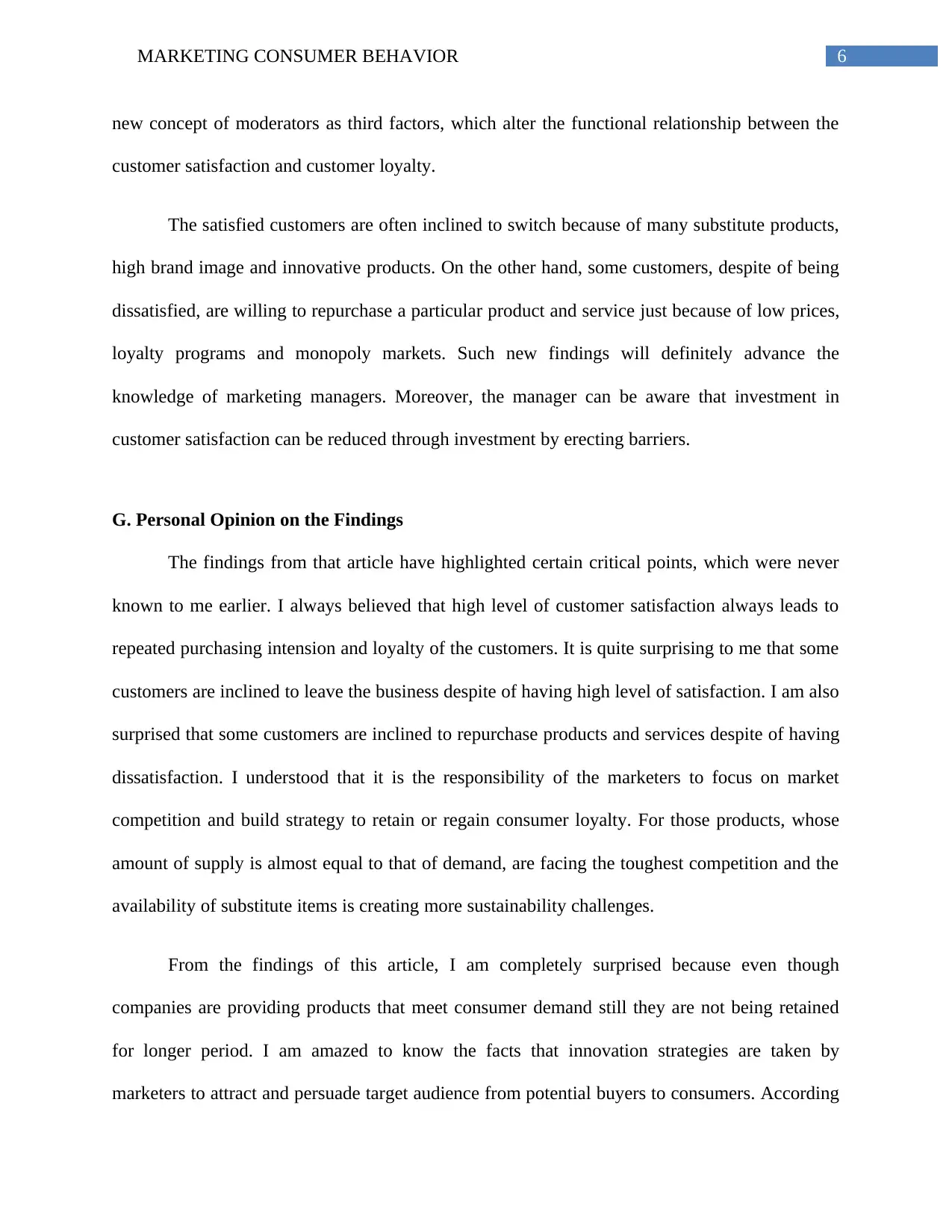
6MARKETING CONSUMER BEHAVIOR
new concept of moderators as third factors, which alter the functional relationship between the
customer satisfaction and customer loyalty.
The satisfied customers are often inclined to switch because of many substitute products,
high brand image and innovative products. On the other hand, some customers, despite of being
dissatisfied, are willing to repurchase a particular product and service just because of low prices,
loyalty programs and monopoly markets. Such new findings will definitely advance the
knowledge of marketing managers. Moreover, the manager can be aware that investment in
customer satisfaction can be reduced through investment by erecting barriers.
G. Personal Opinion on the Findings
The findings from that article have highlighted certain critical points, which were never
known to me earlier. I always believed that high level of customer satisfaction always leads to
repeated purchasing intension and loyalty of the customers. It is quite surprising to me that some
customers are inclined to leave the business despite of having high level of satisfaction. I am also
surprised that some customers are inclined to repurchase products and services despite of having
dissatisfaction. I understood that it is the responsibility of the marketers to focus on market
competition and build strategy to retain or regain consumer loyalty. For those products, whose
amount of supply is almost equal to that of demand, are facing the toughest competition and the
availability of substitute items is creating more sustainability challenges.
From the findings of this article, I am completely surprised because even though
companies are providing products that meet consumer demand still they are not being retained
for longer period. I am amazed to know the facts that innovation strategies are taken by
marketers to attract and persuade target audience from potential buyers to consumers. According
new concept of moderators as third factors, which alter the functional relationship between the
customer satisfaction and customer loyalty.
The satisfied customers are often inclined to switch because of many substitute products,
high brand image and innovative products. On the other hand, some customers, despite of being
dissatisfied, are willing to repurchase a particular product and service just because of low prices,
loyalty programs and monopoly markets. Such new findings will definitely advance the
knowledge of marketing managers. Moreover, the manager can be aware that investment in
customer satisfaction can be reduced through investment by erecting barriers.
G. Personal Opinion on the Findings
The findings from that article have highlighted certain critical points, which were never
known to me earlier. I always believed that high level of customer satisfaction always leads to
repeated purchasing intension and loyalty of the customers. It is quite surprising to me that some
customers are inclined to leave the business despite of having high level of satisfaction. I am also
surprised that some customers are inclined to repurchase products and services despite of having
dissatisfaction. I understood that it is the responsibility of the marketers to focus on market
competition and build strategy to retain or regain consumer loyalty. For those products, whose
amount of supply is almost equal to that of demand, are facing the toughest competition and the
availability of substitute items is creating more sustainability challenges.
From the findings of this article, I am completely surprised because even though
companies are providing products that meet consumer demand still they are not being retained
for longer period. I am amazed to know the facts that innovation strategies are taken by
marketers to attract and persuade target audience from potential buyers to consumers. According
Paraphrase This Document
Need a fresh take? Get an instant paraphrase of this document with our AI Paraphraser
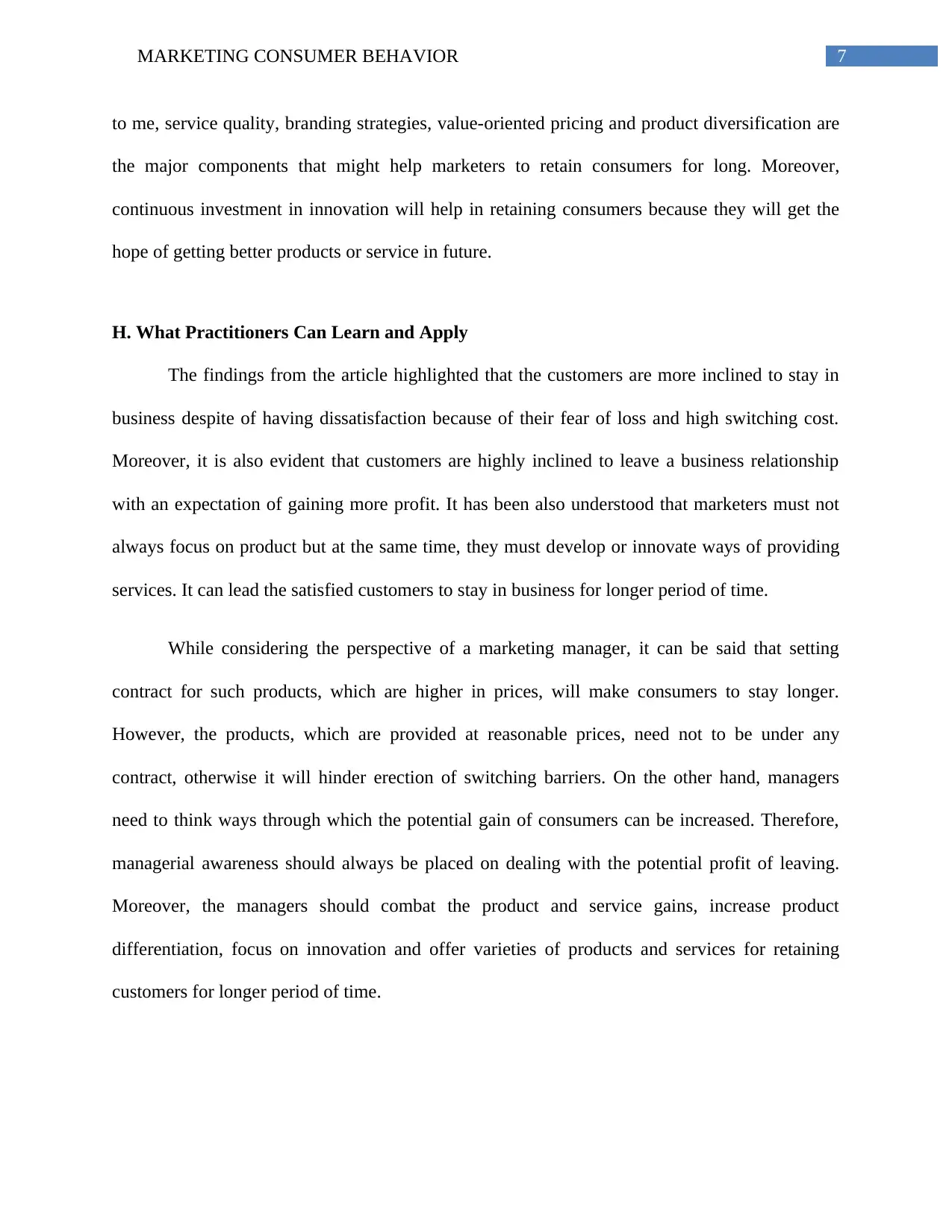
7MARKETING CONSUMER BEHAVIOR
to me, service quality, branding strategies, value-oriented pricing and product diversification are
the major components that might help marketers to retain consumers for long. Moreover,
continuous investment in innovation will help in retaining consumers because they will get the
hope of getting better products or service in future.
H. What Practitioners Can Learn and Apply
The findings from the article highlighted that the customers are more inclined to stay in
business despite of having dissatisfaction because of their fear of loss and high switching cost.
Moreover, it is also evident that customers are highly inclined to leave a business relationship
with an expectation of gaining more profit. It has been also understood that marketers must not
always focus on product but at the same time, they must develop or innovate ways of providing
services. It can lead the satisfied customers to stay in business for longer period of time.
While considering the perspective of a marketing manager, it can be said that setting
contract for such products, which are higher in prices, will make consumers to stay longer.
However, the products, which are provided at reasonable prices, need not to be under any
contract, otherwise it will hinder erection of switching barriers. On the other hand, managers
need to think ways through which the potential gain of consumers can be increased. Therefore,
managerial awareness should always be placed on dealing with the potential profit of leaving.
Moreover, the managers should combat the product and service gains, increase product
differentiation, focus on innovation and offer varieties of products and services for retaining
customers for longer period of time.
to me, service quality, branding strategies, value-oriented pricing and product diversification are
the major components that might help marketers to retain consumers for long. Moreover,
continuous investment in innovation will help in retaining consumers because they will get the
hope of getting better products or service in future.
H. What Practitioners Can Learn and Apply
The findings from the article highlighted that the customers are more inclined to stay in
business despite of having dissatisfaction because of their fear of loss and high switching cost.
Moreover, it is also evident that customers are highly inclined to leave a business relationship
with an expectation of gaining more profit. It has been also understood that marketers must not
always focus on product but at the same time, they must develop or innovate ways of providing
services. It can lead the satisfied customers to stay in business for longer period of time.
While considering the perspective of a marketing manager, it can be said that setting
contract for such products, which are higher in prices, will make consumers to stay longer.
However, the products, which are provided at reasonable prices, need not to be under any
contract, otherwise it will hinder erection of switching barriers. On the other hand, managers
need to think ways through which the potential gain of consumers can be increased. Therefore,
managerial awareness should always be placed on dealing with the potential profit of leaving.
Moreover, the managers should combat the product and service gains, increase product
differentiation, focus on innovation and offer varieties of products and services for retaining
customers for longer period of time.
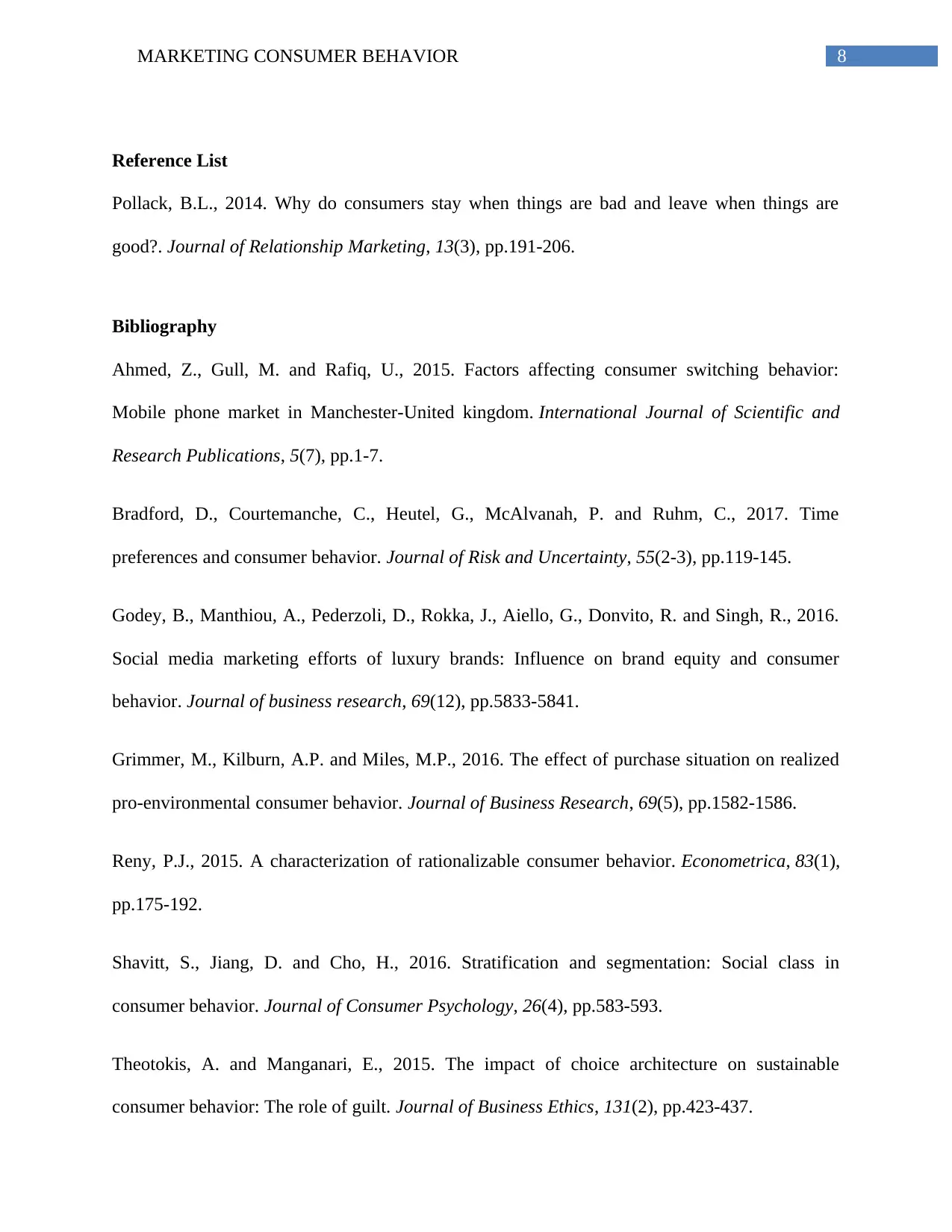
8MARKETING CONSUMER BEHAVIOR
Reference List
Pollack, B.L., 2014. Why do consumers stay when things are bad and leave when things are
good?. Journal of Relationship Marketing, 13(3), pp.191-206.
Bibliography
Ahmed, Z., Gull, M. and Rafiq, U., 2015. Factors affecting consumer switching behavior:
Mobile phone market in Manchester-United kingdom. International Journal of Scientific and
Research Publications, 5(7), pp.1-7.
Bradford, D., Courtemanche, C., Heutel, G., McAlvanah, P. and Ruhm, C., 2017. Time
preferences and consumer behavior. Journal of Risk and Uncertainty, 55(2-3), pp.119-145.
Godey, B., Manthiou, A., Pederzoli, D., Rokka, J., Aiello, G., Donvito, R. and Singh, R., 2016.
Social media marketing efforts of luxury brands: Influence on brand equity and consumer
behavior. Journal of business research, 69(12), pp.5833-5841.
Grimmer, M., Kilburn, A.P. and Miles, M.P., 2016. The effect of purchase situation on realized
pro-environmental consumer behavior. Journal of Business Research, 69(5), pp.1582-1586.
Reny, P.J., 2015. A characterization of rationalizable consumer behavior. Econometrica, 83(1),
pp.175-192.
Shavitt, S., Jiang, D. and Cho, H., 2016. Stratification and segmentation: Social class in
consumer behavior. Journal of Consumer Psychology, 26(4), pp.583-593.
Theotokis, A. and Manganari, E., 2015. The impact of choice architecture on sustainable
consumer behavior: The role of guilt. Journal of Business Ethics, 131(2), pp.423-437.
Reference List
Pollack, B.L., 2014. Why do consumers stay when things are bad and leave when things are
good?. Journal of Relationship Marketing, 13(3), pp.191-206.
Bibliography
Ahmed, Z., Gull, M. and Rafiq, U., 2015. Factors affecting consumer switching behavior:
Mobile phone market in Manchester-United kingdom. International Journal of Scientific and
Research Publications, 5(7), pp.1-7.
Bradford, D., Courtemanche, C., Heutel, G., McAlvanah, P. and Ruhm, C., 2017. Time
preferences and consumer behavior. Journal of Risk and Uncertainty, 55(2-3), pp.119-145.
Godey, B., Manthiou, A., Pederzoli, D., Rokka, J., Aiello, G., Donvito, R. and Singh, R., 2016.
Social media marketing efforts of luxury brands: Influence on brand equity and consumer
behavior. Journal of business research, 69(12), pp.5833-5841.
Grimmer, M., Kilburn, A.P. and Miles, M.P., 2016. The effect of purchase situation on realized
pro-environmental consumer behavior. Journal of Business Research, 69(5), pp.1582-1586.
Reny, P.J., 2015. A characterization of rationalizable consumer behavior. Econometrica, 83(1),
pp.175-192.
Shavitt, S., Jiang, D. and Cho, H., 2016. Stratification and segmentation: Social class in
consumer behavior. Journal of Consumer Psychology, 26(4), pp.583-593.
Theotokis, A. and Manganari, E., 2015. The impact of choice architecture on sustainable
consumer behavior: The role of guilt. Journal of Business Ethics, 131(2), pp.423-437.
You're viewing a preview
Unlock full access by subscribing today!
1 out of 9
Related Documents
Your All-in-One AI-Powered Toolkit for Academic Success.
+13062052269
info@desklib.com
Available 24*7 on WhatsApp / Email
![[object Object]](/_next/static/media/star-bottom.7253800d.svg)
Unlock your academic potential
© 2024 | Zucol Services PVT LTD | All rights reserved.





